Dima Damen
Leveraging Auxiliary Information in Text-to-Video Retrieval: A Review
May 29, 2025Abstract:Text-to-Video (T2V) retrieval aims to identify the most relevant item from a gallery of videos based on a user's text query. Traditional methods rely solely on aligning video and text modalities to compute the similarity and retrieve relevant items. However, recent advancements emphasise incorporating auxiliary information extracted from video and text modalities to improve retrieval performance and bridge the semantic gap between these modalities. Auxiliary information can include visual attributes, such as objects; temporal and spatial context; and textual descriptions, such as speech and rephrased captions. This survey comprehensively reviews 81 research papers on Text-to-Video retrieval that utilise such auxiliary information. It provides a detailed analysis of their methodologies; highlights state-of-the-art results on benchmark datasets; and discusses available datasets and their auxiliary information. Additionally, it proposes promising directions for future research, focusing on different ways to further enhance retrieval performance using this information.
The Invisible EgoHand: 3D Hand Forecasting through EgoBody Pose Estimation
Apr 11, 2025Abstract:Forecasting hand motion and pose from an egocentric perspective is essential for understanding human intention. However, existing methods focus solely on predicting positions without considering articulation, and only when the hands are visible in the field of view. This limitation overlooks the fact that approximate hand positions can still be inferred even when they are outside the camera's view. In this paper, we propose a method to forecast the 3D trajectories and poses of both hands from an egocentric video, both in and out of the field of view. We propose a diffusion-based transformer architecture for Egocentric Hand Forecasting, EgoH4, which takes as input the observation sequence and camera poses, then predicts future 3D motion and poses for both hands of the camera wearer. We leverage full-body pose information, allowing other joints to provide constraints on hand motion. We denoise the hand and body joints along with a visibility predictor for hand joints and a 3D-to-2D reprojection loss that minimizes the error when hands are in-view. We evaluate EgoH4 on the Ego-Exo4D dataset, combining subsets with body and hand annotations. We train on 156K sequences and evaluate on 34K sequences, respectively. EgoH4 improves the performance by 3.4cm and 5.1cm over the baseline in terms of ADE for hand trajectory forecasting and MPJPE for hand pose forecasting. Project page: https://masashi-hatano.github.io/EgoH4/
Leveraging Modality Tags for Enhanced Cross-Modal Video Retrieval
Apr 03, 2025


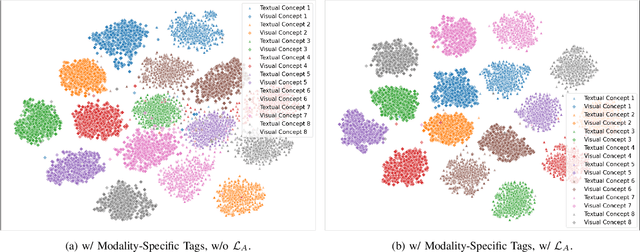
Abstract:Video retrieval requires aligning visual content with corresponding natural language descriptions. In this paper, we introduce Modality Auxiliary Concepts for Video Retrieval (MAC-VR), a novel approach that leverages modality-specific tags -- automatically extracted from foundation models -- to enhance video retrieval. We propose to align modalities in a latent space, along with learning and aligning auxiliary latent concepts, derived from the features of a video and its corresponding caption. We introduce these auxiliary concepts to improve the alignment of visual and textual latent concepts, and so are able to distinguish concepts from one other. We conduct extensive experiments on five diverse datasets: MSR-VTT, DiDeMo, TGIF, Charades and YouCook2. The experimental results consistently demonstrate that modality-specific tags improve cross-modal alignment, outperforming current state-of-the-art methods across three datasets and performing comparably or better across the other two.
Learning from Streaming Video with Orthogonal Gradients
Apr 02, 2025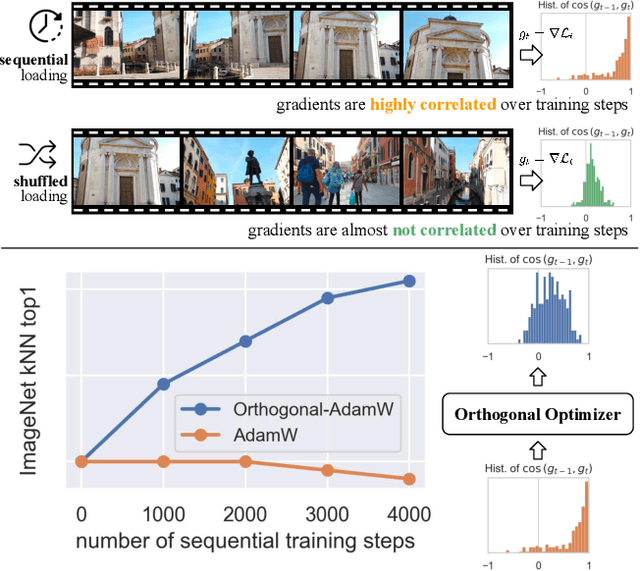
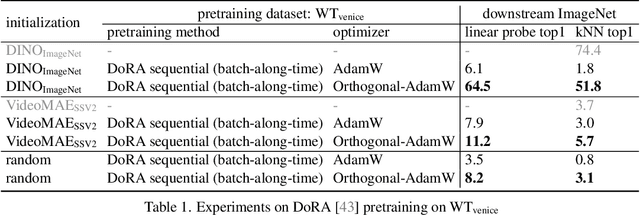
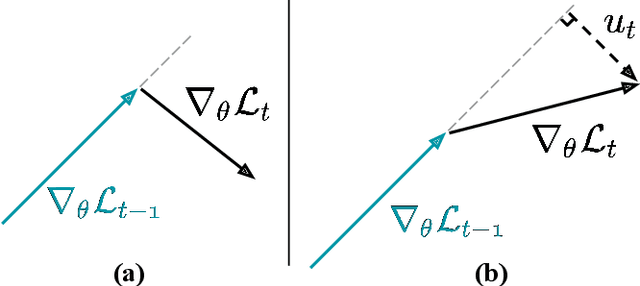
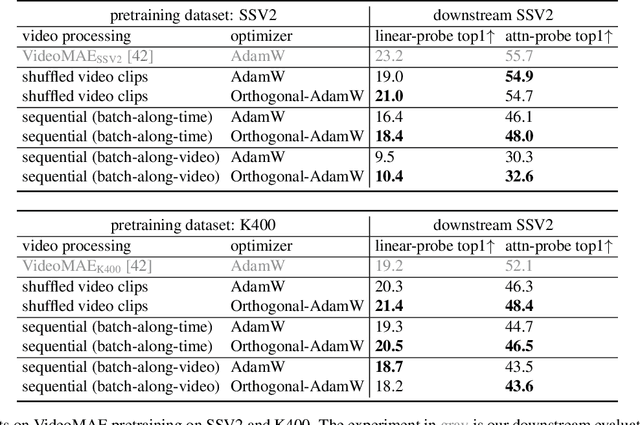
Abstract:We address the challenge of representation learning from a continuous stream of video as input, in a self-supervised manner. This differs from the standard approaches to video learning where videos are chopped and shuffled during training in order to create a non-redundant batch that satisfies the independently and identically distributed (IID) sample assumption expected by conventional training paradigms. When videos are only available as a continuous stream of input, the IID assumption is evidently broken, leading to poor performance. We demonstrate the drop in performance when moving from shuffled to sequential learning on three tasks: the one-video representation learning method DoRA, standard VideoMAE on multi-video datasets, and the task of future video prediction. To address this drop, we propose a geometric modification to standard optimizers, to decorrelate batches by utilising orthogonal gradients during training. The proposed modification can be applied to any optimizer -- we demonstrate it with Stochastic Gradient Descent (SGD) and AdamW. Our proposed orthogonal optimizer allows models trained from streaming videos to alleviate the drop in representation learning performance, as evaluated on downstream tasks. On three scenarios (DoRA, VideoMAE, future prediction), we show our orthogonal optimizer outperforms the strong AdamW in all three scenarios.
Moment of Untruth: Dealing with Negative Queries in Video Moment Retrieval
Feb 12, 2025Abstract:Video Moment Retrieval is a common task to evaluate the performance of visual-language models - it involves localising start and end times of moments in videos from query sentences. The current task formulation assumes that the queried moment is present in the video, resulting in false positive moment predictions when irrelevant query sentences are provided. In this paper we propose the task of Negative-Aware Video Moment Retrieval (NA-VMR), which considers both moment retrieval accuracy and negative query rejection accuracy. We make the distinction between In-Domain and Out-of-Domain negative queries and provide new evaluation benchmarks for two popular video moment retrieval datasets: QVHighlights and Charades-STA. We analyse the ability of current SOTA video moment retrieval approaches to adapt to Negative-Aware Video Moment Retrieval and propose UniVTG-NA, an adaptation of UniVTG designed to tackle NA-VMR. UniVTG-NA achieves high negative rejection accuracy (avg. $98.4\%$) scores while retaining moment retrieval scores to within $3.87\%$ Recall@1. Dataset splits and code are available at https://github.com/keflanagan/MomentofUntruth
HD-EPIC: A Highly-Detailed Egocentric Video Dataset
Feb 06, 2025Abstract:We present a validation dataset of newly-collected kitchen-based egocentric videos, manually annotated with highly detailed and interconnected ground-truth labels covering: recipe steps, fine-grained actions, ingredients with nutritional values, moving objects, and audio annotations. Importantly, all annotations are grounded in 3D through digital twinning of the scene, fixtures, object locations, and primed with gaze. Footage is collected from unscripted recordings in diverse home environments, making HDEPIC the first dataset collected in-the-wild but with detailed annotations matching those in controlled lab environments. We show the potential of our highly-detailed annotations through a challenging VQA benchmark of 26K questions assessing the capability to recognise recipes, ingredients, nutrition, fine-grained actions, 3D perception, object motion, and gaze direction. The powerful long-context Gemini Pro only achieves 38.5% on this benchmark, showcasing its difficulty and highlighting shortcomings in current VLMs. We additionally assess action recognition, sound recognition, and long-term video-object segmentation on HD-EPIC. HD-EPIC is 41 hours of video in 9 kitchens with digital twins of 413 kitchen fixtures, capturing 69 recipes, 59K fine-grained actions, 51K audio events, 20K object movements and 37K object masks lifted to 3D. On average, we have 263 annotations per minute of our unscripted videos.
Scaling 4D Representations
Dec 19, 2024



Abstract:Scaling has not yet been convincingly demonstrated for pure self-supervised learning from video. However, prior work has focused evaluations on semantic-related tasks $\unicode{x2013}$ action classification, ImageNet classification, etc. In this paper we focus on evaluating self-supervised learning on non-semantic vision tasks that are more spatial (3D) and temporal (+1D = 4D), such as camera pose estimation, point and object tracking, and depth estimation. We show that by learning from very large video datasets, masked auto-encoding (MAE) with transformer video models actually scales, consistently improving performance on these 4D tasks, as model size increases from 20M all the way to the largest by far reported self-supervised video model $\unicode{x2013}$ 22B parameters. Rigorous apples-to-apples comparison with many recent image and video models demonstrates the benefits of scaling 4D representations.
EgoPoints: Advancing Point Tracking for Egocentric Videos
Dec 05, 2024



Abstract:We introduce EgoPoints, a benchmark for point tracking in egocentric videos. We annotate 4.7K challenging tracks in egocentric sequences. Compared to the popular TAP-Vid-DAVIS evaluation benchmark, we include 9x more points that go out-of-view and 59x more points that require re-identification (ReID) after returning to view. To measure the performance of models on these challenging points, we introduce evaluation metrics that specifically monitor tracking performance on points in-view, out-of-view, and points that require re-identification. We then propose a pipeline to create semi-real sequences, with automatic ground truth. We generate 11K such sequences by combining dynamic Kubric objects with scene points from EPIC Fields. When fine-tuning point tracking methods on these sequences and evaluating on our annotated EgoPoints sequences, we improve CoTracker across all metrics, including the tracking accuracy $\delta^\star_{\text{avg}}$ by 2.7 percentage points and accuracy on ReID sequences (ReID$\delta_{\text{avg}}$) by 2.4 points. We also improve $\delta^\star_{\text{avg}}$ and ReID$\delta_{\text{avg}}$ of PIPs++ by 0.3 and 2.8 respectively.
ShowHowTo: Generating Scene-Conditioned Step-by-Step Visual Instructions
Dec 02, 2024



Abstract:The goal of this work is to generate step-by-step visual instructions in the form of a sequence of images, given an input image that provides the scene context and the sequence of textual instructions. This is a challenging problem as it requires generating multi-step image sequences to achieve a complex goal while being grounded in a specific environment. Part of the challenge stems from the lack of large-scale training data for this problem. The contribution of this work is thus three-fold. First, we introduce an automatic approach for collecting large step-by-step visual instruction training data from instructional videos. We apply this approach to one million videos and create a large-scale, high-quality dataset of 0.6M sequences of image-text pairs. Second, we develop and train ShowHowTo, a video diffusion model capable of generating step-by-step visual instructions consistent with the provided input image. Third, we evaluate the generated image sequences across three dimensions of accuracy (step, scene, and task) and show our model achieves state-of-the-art results on all of them. Our code, dataset, and trained models are publicly available.
Perception Test 2024: Challenge Summary and a Novel Hour-Long VideoQA Benchmark
Nov 29, 2024



Abstract:Following the successful 2023 edition, we organised the Second Perception Test challenge as a half-day workshop alongside the IEEE/CVF European Conference on Computer Vision (ECCV) 2024, with the goal of benchmarking state-of-the-art video models and measuring the progress since last year using the Perception Test benchmark. This year, the challenge had seven tracks (up from six last year) and covered low-level and high-level tasks, with language and non-language interfaces, across video, audio, and text modalities; the additional track covered hour-long video understanding and introduced a novel video QA benchmark 1h-walk VQA. Overall, the tasks in the different tracks were: object tracking, point tracking, temporal action localisation, temporal sound localisation, multiple-choice video question-answering, grounded video question-answering, and hour-long video question-answering. We summarise in this report the challenge tasks and results, and introduce in detail the novel hour-long video QA benchmark 1h-walk VQA.
 Add to Chrome
Add to Chrome Add to Firefox
Add to Firefox Add to Edge
Add to Edge